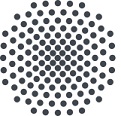Bitte benutzen Sie diese Kennung, um auf die Ressource zu verweisen:
http://dx.doi.org/10.18419/opus-4824
| Autor(en): | Engel, Michael |
| Titel: | Dynamics and defects of complex crystals and quasicrystals : perspectives from simple model systems |
| Sonstige Titel: | Modellstudien zur Dynamik und zu Defekten komplexer Kristalle und Quasikristalle |
| Erscheinungsdatum: | 2008 |
| Dokumentart: | Dissertation |
| URI: | http://nbn-resolving.de/urn:nbn:de:bsz:93-opus-34692 http://elib.uni-stuttgart.de/handle/11682/4841 http://dx.doi.org/10.18419/opus-4824 |
| Zusammenfassung: | Komplexe Kristalle und Quasikristalle sind geordnete Festkörperstrukturen mit sehr großen beziehungsweise unendlichen großen Einheitszellen. Ihre Teilchendynamik unterscheidet sich grundlegend von derjenigen der einfachen Kristalle: Aufgrund der strukturellen Komplexität treten lokale Umordnungen, sogenannte Phasonflips, und neueartige Versetzungen auf. Um das Verhalten auf einer elementaren Ebene zu verstehen, werden drei ein- und zweidimensionale Modellsysteme eingeführt. Die Systeme werden sowohl analytisch, als auch mit numerischen Simulationen untersucht.
(i) Die Strukturfaktoren der dynamischen Fibonacci-Kette wurden in hoher Auflösung berechnet. Sie zeigen eine charakteristische Verbreiterung der Phonondispersionsrelation. Die Teilchendynamik im Realraum zeichnet sich durch Soliton- und Breathermoden aus, welche zusammen mit Phasonflips auftreten.
(ii) Mit Hilfe eines Tilingmodells wurde die experimentelle Beobachtung von Metaversetzungen im intermetallischen System AlPdMn und die damit verbundene kollektive strukturelle Umordnung erklärt. Die Burgersvektoren der Versetzungen können aus Energieüberlegungen abgeleitet werden.
(iii) Im Lennard-Jones-Gauß-System treten eine überaschende Vielzahl an zweidimensionalen komplexen Kristallen, ein dekagonaler und zwei dodekagonale Quasikristalle auf. Bei Temperaturen nahe des Schmelzpunktes ordnen sich die Teilchen per Phasonflips um. Während des Abkühlens transformieren sich die entropisch stabilisierten Quasikristalle reversibel in komplexe Kristalle. Mit dem Lennard-Jones-Gauß-System ist es zum ersten Mal möglich, das Wachstum, die Gleichgewichtsdynamik und die Defekte von Quasikristallen und komplexen Kristallen in Simulationen zu untersuchen. Complex crystals and quasicrystals are ordered states of matter with very large or even infinite unit cells. Their particle dynamics and defects differ significantly from what is known for simple crystals: Local rearrangements, phason flips, and new types of dislocations are consequences of the structural complexity. In order to understand their behavior at an elementary level, we introduce three model systems in one and two dimensions. The systems are studied analytically and with numerical simulations. (i) The structure factors of the dynamic Fibonacci chain are computed with high resolution. They show a characteristic broadening of the phonon dispersion relation. The particle motion in real space reveals soliton and breather modes, closely connected to phason flips. (ii) Using a tiling model for the intermetallic system AlPdMn, experimental observations of metadislocations and the collective particle dynamics are explained. The Burgers vectors of stable dislocations are derived from energy considerations. (iii) In the Lennard-Jones-Gauss system a surprising variety of two-dimensional complex crystals as well as a decagonal and two dodecagonal quasicrystals are grown. The particles reorder by phason flips at elevated temperatures. During annealing, the entropically stabilized quasicrystals undergo reversible phase transitions into complex crystals. Competing interparticle distances seem to favor structural complexity. With the Lennard-Jones-Gauss system the growth, equilibrium dynamics, and defects of quasicrystals and complex crystals can be studied in simulations for the first time. |
| Enthalten in den Sammlungen: | 08 Fakultät Mathematik und Physik |
Dateien zu dieser Ressource:
| Datei | Beschreibung | Größe | Format | |
|---|---|---|---|---|
| engel_thesis.pdf | 17,91 MB | Adobe PDF | Öffnen/Anzeigen |
Alle Ressourcen in diesem Repositorium sind urheberrechtlich geschützt.

